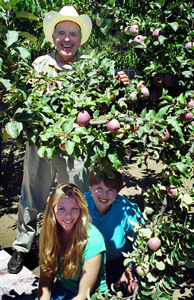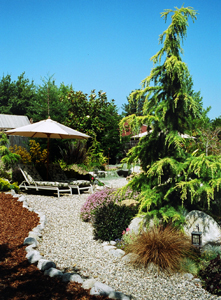![[Metroactive Features]](/features/gifs/feat468.gif)
[ Features Index | Santa Cruz Week | SantaCruz Home | Archives ]
![[line]](/gifs/line.gif)
Home & Garden Issue
Local gardeners carve out slices of paradise in the most unlikely places By Peter Koht Eden doesn't auto-generate. Of the three gardeners featured in this story, none had the good fortune to move into a space that was immediately ready for cultivation: Jose Sanchez's garden sits on top of a crumbly marine terrace, Des Brose's was built on top of a flood-prone, manure-filled paddock and Ed Noffsinger's terraced garden was carved out from a scrub-filled ridgeline. Through a combination of ingenuity, engineering and a hell of a lot of hard work, these three gardeners have managed to create lush and verdant spaces out of former eyesores. "We had to move in the biggest Caterpillar earthmover that this neighborhood had ever seen to carve out the terraces," says Scotts Valley resident Noffsinger. "In fact, the caterpillar's arm had to be used to get the flatbed around the last turn!" Over on the West Side, Des Brose was living with 12 horses outside her window, and the neighbors were less than thrilled about l'eau de ranch that drifted in their windows along with the sea breezes. After the horses found new homes, she and her husband, Karl, cleared off the land and dug a pond. Everything was gorgeous until the rains came. Over the next two winters, the pond flooded both of its banks and left the yard a morass of mud. Clearly some hydrological engineering was in order. "Getting the water down the hill when it rained was a huge project," she says, surveying the three water features that now step their way down her backyard. "Now one gravel-and-rock garden path doubles as a stream during the winter and there are a series of drains throughout the property to make sure that all the water ends up in the ravine behind the house."
Believe It or Not: Scotts Valley's Noffsinger clan live in a microclimate that sustains subtropical fruits and flora. Once such spaces are cleared and made ready for cultivation, there is still the question of what to actually put in the gardens. Out in Scotts Valley, Noffsinger's property sits in an elusive microclimate that is referred to as Zone 16. When Scotts Valley gets slogged in freezing mists, warm air displaced by the fog rushes up the hill to his ridge and blesses it with temperate evenings and winters. This climactic good fortune allows Ed and his wife, Janet, to grow subtropical fruits and flora that would otherwise freeze down in Santa Cruz. Walking around his garden, mere feet away from the redwoods, you can find macadamia nut trees and passion fruit vines that are more then 10 meters long. He even has several varieties of sapote, a Central American fruit whose taste is "like crème brulée without the guilt." Jose Sanchez, a lead groundskeeper for UCSC's Housing, Dining and Childcare Services, populates his small patch of paradise near downtown Santa Cruz with less exotic fare. Working with leftovers from projects and some clippings, he uses his space as a place for professional development. "I want to try every plant that I come across and to learn how they grow in different conditions." he says. His space is also a model of economy. Working without an irrigation system, he had to design the space to be highly water retentive, with shade plants and ground cover creating moisture traps to keep the water in the soil instead of spilling over the terrrace that truncates the back border of the garden. Sanchez's space is also a huge recycling project, with multiple compost bins and a vermiculture setup that greatly diminishes house waste while producing lush topsoil for the beds and planters. "I used to hide the compost bins in the back," Sanchez says, "but now I built a special place for them within the garden. I don't want to hide it, because it's a part of the process and compost is beautiful."
Economy also plays into Brose's design. With a swimming pool, a massive fountain, dozens of beds (including a carnivorous bog garden) and a gorgeous stream, her water bill would be astronomical if not for an ingenious innovation that her husband, Karl, came up with. "All of the showers and sinks drain to a 1,500-gallon tank sunk under the house, then the gray water is pumped up through a drip system to keep everything watered." These gardens are all long-term, time-consuming projects. Noffsinger's terraces have been under constant construction for 23 years, Sanchez's for eight and Brose's for 2 1/2. But the temporal investment yields high returns of serenity and beauty. Of all the gardeners interviewed, Noffsinger has the most poignant reason for creating his tropically themed space, "I used to be the director of Kaiser's Oncology Counseling and Chronic Illness Services Department," he says surveying the view over his varietals. "While I loved the job, I had to deal with death and dying all day long. After a hard day I would come home and plant a tree to experience the beauty of life again." [ Santa Cruz Week | Metroactive Central | Archives ]
|
From the August 17-24, 2005 issue of Metro Santa Cruz.
Copyright © 2005 Metro Publishing Inc. Maintained by Boulevards New Media.
For more information about Santa Cruz, visit santacruz.com.


